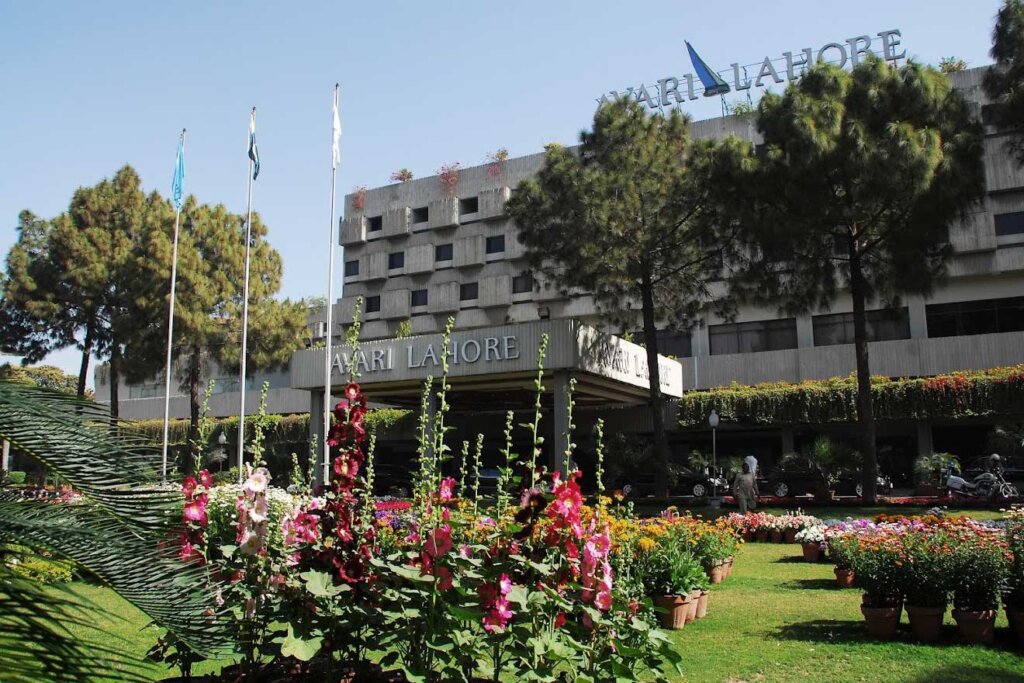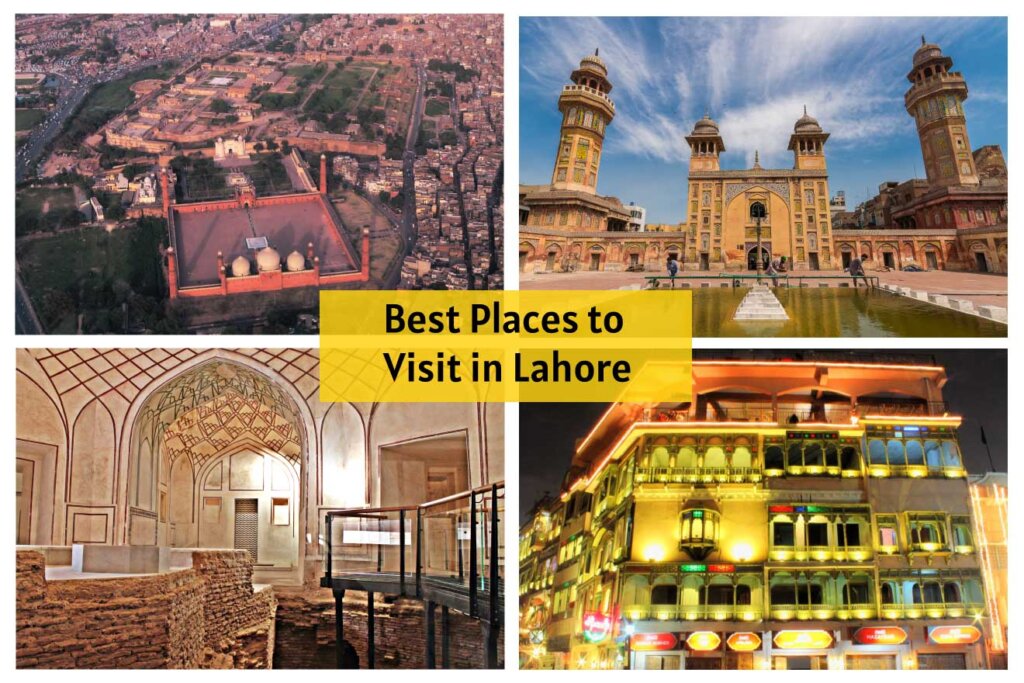
Lahore, the cultural capital of Pakistan, has much to offer with centuries-old historical sites and a huge Mughal-era walled city that won’t stop amusing the tourists.
This metropolitan city showcases the heady mix of modernity and old times. With many enchanting places that reflect the history, you will never have a dull moment while visiting Lahore.
From magnificent monuments to elite shopping malls and beautiful parks to incredible dining options, it has plentiful tourist attractions to get a glimpse of Pakistan’s history and living heritage.
Lahore is also known for mouthwatering food and bustling bazaars and markets. The long list of the best places to visit in Lahore often gives nightmares to tourists and even established trip planners.
We’ve compiled a list of the top 15 best places to visit in this bustling and vibrant city. Let’s get into it!
15 best places to visit in Lahore
1-Lahore Walled City
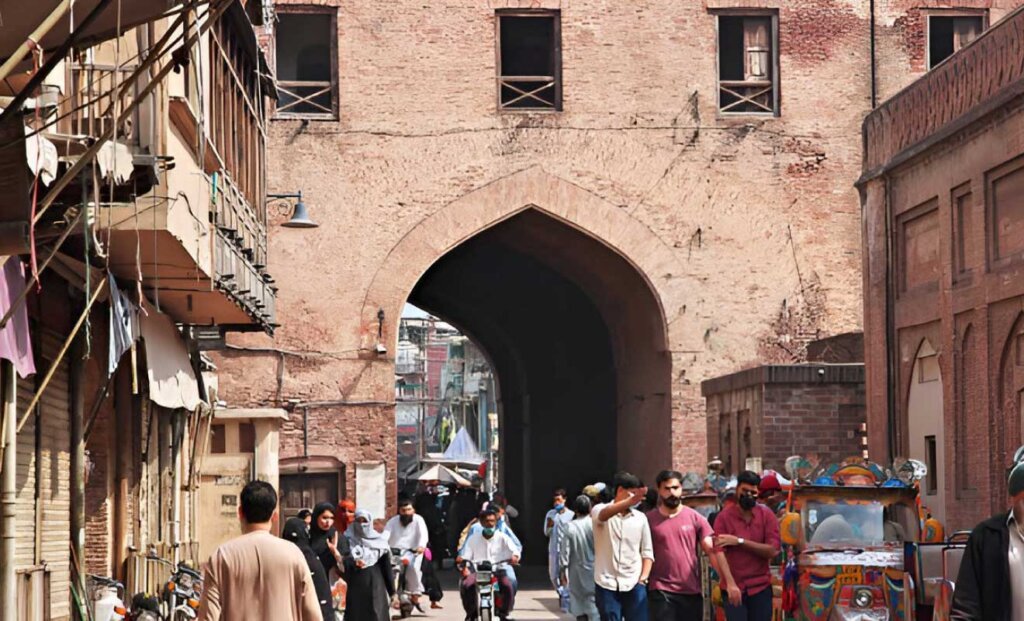
A city surrounded by fortified walls and numerous gates was built thousands of years ago. It is known as the Walled City of Lahore or ‘Androon Lahore.’ It is an architectural marvel in itself, protecting landmarks with rich history, centuries-old bustling markets, and culture intertwined with traditional cuisines and prestigious architecture.
This open utopia is home to many UNESCO Heritage Sites, religious attractions, old havelis, and iconic structures from the Mughal and Sikh periods. The walled city of Lahore is densely packed, and all the landmarks are within walking distance and can be explored in a couple of days. Make a point to explore all these best places to visit in the Walled City of Lahore.
You will literally get lost in the magic of narrow lanes and bustling bazaars without a destination. Exploring Lahore’s old gates is also worth a visit. You can enter any gate of this heritage city, wander around, and see where your feet take you. You will be greeted with narrow walkways, magnificent havelis that stand as a masterpiece, more than 100 years old eateries serving every imaginable delicacy, and unknown shrines on your visit to the Walled City of Lahore.
The old city is also known as the cultural heart of Lahore and home to the best restaurants in Lahore. It is also recognized for having the best street food vendors in Pakistan, which offer delicious street food that takes your taste buds on a gastronomic journey.
If you are a foodie, roam the streets of the old city and enjoy street food to explore Pakistan’s rich gastronomic heritage. It is recommended to allocate an ample amount of time for roaming into this cultural center of the Punjab. Booking one of the best hotels in Lahore near Walled City gives you easy access to many monuments.
 Location:
Location:
North-west area of Lahore
 How to get there:
How to get there:
15-minute drive time from Mall Road, Lahore
 Highlights:
Highlights:
Lahore Fort, Badshahi Mosque, Wazir Khan Masjid, Sunehri mosque, Begum Shahi Mosque, Havelis, including the famous Barood Khana and Nau Nihal Singh Haveli, Shahi Hamam, Fort Road food street, six historic gates, including the famous Delhi Gate, Shahi Guzargah between Delhi Gate and Wazir Khan mosque, Asia’s largest spice market, Akbari mandi, Well of Dena Nath, and shrines.
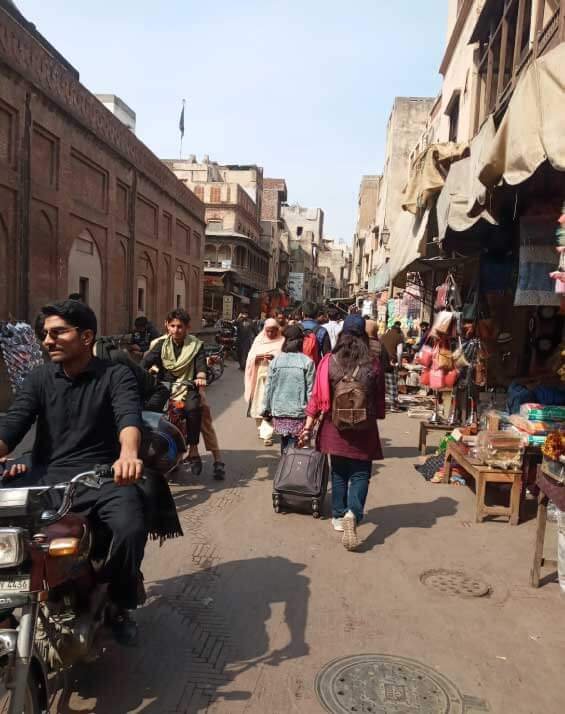
2-Wazir khan Masjid

Wazir Khan Masjid is yet another relic of the ancient Mughal Empire, which was commissioned by Mughal Emperor Shah Jahan. A less than five-minute walk from Delhi gate takes you to the invigorating Wazir Khan Mosque, which is known for its extensive and intricate embellishment. It features intricate faience tile work (Kashi-Kari) that adorns the four minarets and exterior, and magnificent buon frescoes embellish its interior.
Almost every inch of its interior surface is richly decorated with Mughal frescoes and intricate floral motifs, including its archways, muqarnas, and ceilings, making it one of the most ornately decorated Mughal-era mosques.
This living piece of history is still in good condition even after nearly 400 years due to the restoration work. Intricate tilework will capture your attention as soon as you approach the mosque’s main entrance. The view from one of the mosque’s minarets is quite fantastic and gives you the chance to see the bird’s eye view of the entire mosque and streets of the Walled City of Lahore.
Although this mid-16th-century mosque is not bigger than Badshahi Mosque, it is nevertheless one of the best places to visit in Lahore. It is free to enter and open daily between 5 am and 8 pm.
 Location:
Location:
Shahi Guzargah, Walled City of Lahore
 How to get there:
How to get there:
Less than a 5-minute walk from Delhi Gate.
 Highlights:
Highlights:
Elaborated tile work and calligraphy on façade facing Wazir Khan Chowk, square pavilion of main prayer hall, fresco work on the underside of the dome feature depicting the Islamic concept of paradise, Timurid-style Iwan, Tomb of Sufi saint Mian Mir, ablution pool, bird’s-eye view of the mosque from the mosque’s minaret, buon frescoes on interior surfaces, and intricate faience tile work on minarets and exterior.
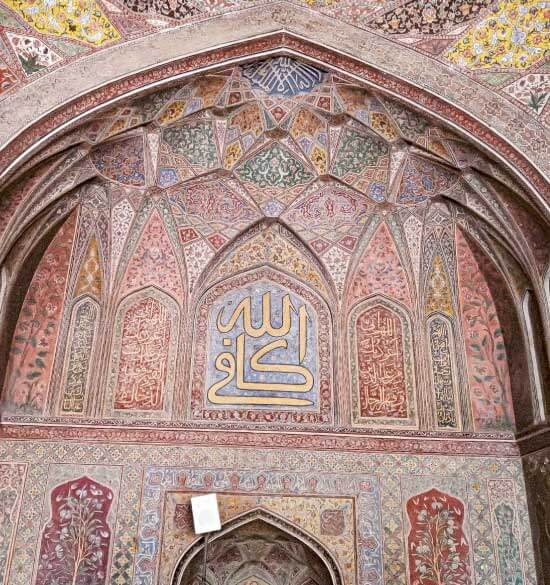
3-Shahi Hamam:
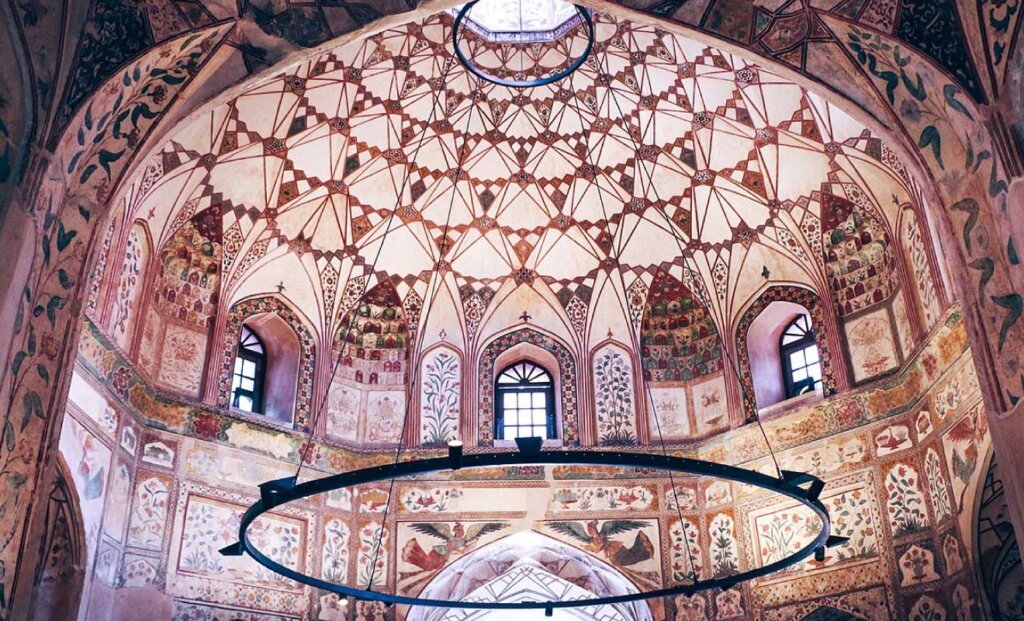
Another historical place in our list of best visiting places in Lahore is Shahi Hamam, or royal bath, located within the Walled City of Lahore near Delhi Gate. It was built in the 17th century during the reign of Mughal Emperor Shah Jahan. Shahi Hamam is the last remaining Mughal-era royal bath, restored between 2013 and 2015 with support from the government of Norway, and Aga Khan Trust for Culture. Its walls are richly decorated with colorful Mughal-era frescoes depicting winged angels, which remain intact after more than 300 years.
Most of its interior was preserved intact. The elevated walkways have been constricted to keep it preserved. It is a Turkish bath with three main parts: garm hamam, jama khana, and nim garm. This Mughal-era hamam also features a small prayer room and reception chamber. Its central dome is adorned with geometric frescoes. The ceiling and walls of its main hall feature colorful designs and motifs.
This exquisite royal bath is a single-storey building with 21 inter-connected rooms. The main room is constructed in an octagon shape where you can hear a whisper of another person standing in the other corner of the room. Its waiting area has been converted into a conference room where tourists can watch the documentary to understand how its restoration work was carried out. Plus, information displays inside each section of Shahi Hamam offer great information to the visitors.
It also features a café where visitors can enjoy delicious local food. You will find Asia’s oldest spice market, Akbari Mandi, and the famous Delhi Gate market outside its main entrance. Tourists are treated like royalty and welcomed with a brass band performance on their visit to Shahi Hamam, providing them with a truly royal experience. It is open to the public from 9 am to 5 pm every day, and the entrance fee is 150 rupees for local visitors.
 Location:
Location:
Akbari Mandi, Walled City of Lahore
 How to get there:
How to get there:
Around 2 min short walk from the Delhi Gate
 Highlights:
Highlights:
Fresco work, especially under the main dome, rooms with an echo system, three main parts of bath, central chamber, a café, geometric ceiling designs on side chambers, and hypocausts.
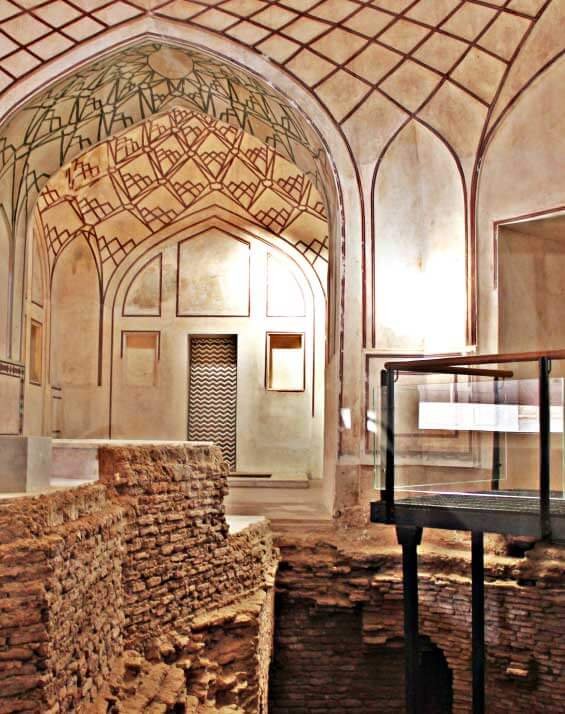
4-The Delhi Gate
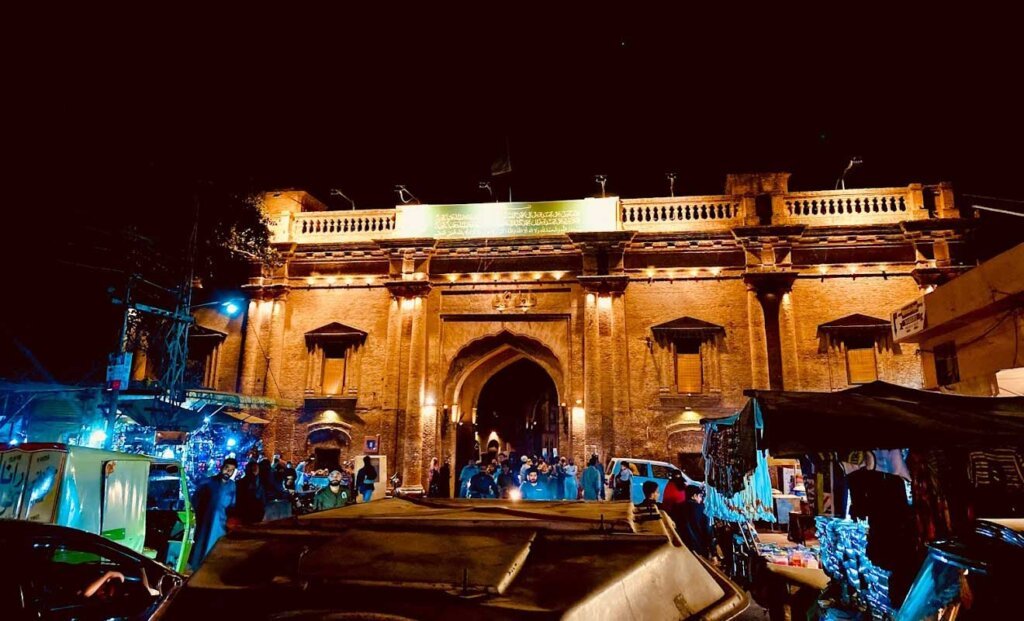
There were 13 gates built around the ancient city of Lahore during the Mughal Emperor Akbar period, and most of them were destroyed during British rule on the subcontinent. Delhi Gate is one of the six remaining old gates of Lahore that was restored in 2015. This historical landmark is included in the list of famous places in Lahore, facing eastward toward India’s capital, Delhi. Its two-storey structure is illuminated at night, and its rooftop can be accessed by a staircase.
This historic gate is located next to Akbari Mandi, and it takes over 10 minutes to get there by road from Minar-e-Pakistan. Delhi Gate is adjacent to the famous Shahi Hamam and opens into a bazaar leading to the 17th-century Wazir Khan Masjid mosque. Inside the Bazaar, you will find all sorts of shops selling handicrafts, traditional clothes, and souvenirs.
Delhi Gate market and its surrounding area feature narrow lanes that can be explored on foot. These narrow streets are unique as only one person can walk at one time in these narrow lanes. The famous street inside the gate is Gali Surjan Singh and Patli Gali. Gali Surjan Singh opens at the Delhi Gate and comprises houses, small storefronts with architectural and historic value, and the famous Usman Ki Baithak, a sitting area for tourists.
Every corner of this street resonates with the essence of the walled city of Lahore. Walking inside the Delhi Gate lets you feel that it is a place where echoes of the bygone era whisper through narrow alleys. It is a living relic of times past and gives you a glimpse of simpler local life. Delhi Gate is an excellent place for photographers to take great pictures and shoot time lapse videos if time permits.
 Location:
Location:
Walled City of Lahore
 How to get there:
How to get there:
Over a 10-minute drive from Minar-e-Pakistan
 Highlights:
Highlights:
Delhi Gate market, Gali Surjan Singh, Usman ki Beithak, Patli Gali, 200 years old Mughal’s well or Mughal Da Kho, Sabeel Wali Gali, intricate woodwork on windows and balconies of the houses, the Kashmiri bazaar, and nearby Shahi Hamam and Wazir Khan Masjid.

Don’t forget to check out as well…
5-Lahore Fort- Best Place to visit in Lahore
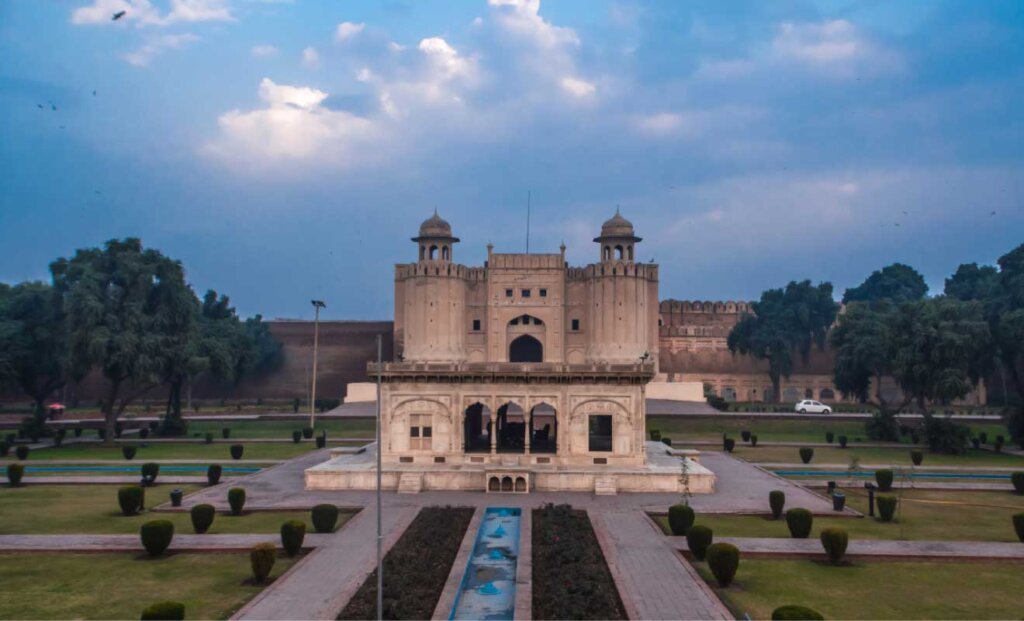
Lahore Fort, locally known as ‘Shahi Qila’, is widely considered one of the top 10 places to visit in Lahore, which dates back to the 11th century when it was a mud-brick fortified structure. The modern Lahore fort was built in 1566 during the reign of Emperor Akbar, and it was modified in the 17th century during the Mughal emperors that came after.
It is located right at the front of Badshahi Mosque and spreads over 20 hectares. This centuries-old Fort houses numerous museums, ornate royal palaces, majestic elephant paths, ancient paintings, picture walls, immaculate gardens, pavilions, mosques, and more.
The Fort’s complex is huge and home to 21 notable monuments, some of which date back to Akbar the Great’s period. Furthermore, it offers stunning views of Minar-e-Pakistan and Badshahi Mosque, making it hard for you to find a historical place in Lahore that exhibits a more raw history than this citadel.
The jewel in the Fort’s crown is Sheesh Mahal, known for its intricate mirror work on marble walls and pavilion inlaid with pichikari or pietra dura. This palace is located within the Shah Burji or King’s Pavilion and takes its name from the reflective mirror tiles that elicit a glistening effect and embellish the interior.
Best of all, visitors can get a view of Badshahi Mosque and Lahore Fort from this UNESCO Heritage Site. Visitors need to pay an extra 100 rupees to visit Sheesh Mahal. Lahore Fort is so huge, so allocate at least half a day to wander around its gardens, museums, and palaces. The entry ticket fee is 50 rupees for locals and 500 rupees for foreign tourists.
It is one of the best places to visit in Lahore with families. It is open to the public from 8 a.m. to 5 p.m. daily. It receives more visitors on weekends and during public holidays, so plan your visit during weekdays to avoid crowds.
 Location:
Location:
Fort Road, walled city of Lahore
 How to get there:
How to get there:
 A short walk from Badshahi Mosque
A short walk from Badshahi Mosque
Highlights:
The Sheesh Mahal, Alamgiri Gate, Moti Masjid, museum of Mughal antiquities, Khawabgarh-i-Jehangir, Diwan-i-Khas, Naulakha pavilion, Elephant Path, Armoury Gallery, Jahangir Quadrangle, picture wall, Sikh Gallery, Shah Burj Gate, and golf-cart tour.
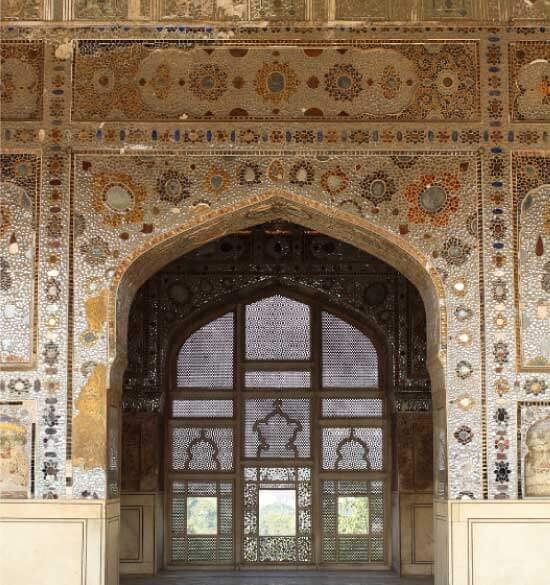
6- Badshahi Mosque

Badshahi Mosque is one of the must-see places to visit in Lahore, which was constructed during the era of Mughal Emperor Aurangzeb. This 17th-century mosque is located right next to Lahore Fort and is made of carved red sandstone inlaid with elaborately carved marble, giving it its unique color.
Badshahi Mosque’s design is closely reminiscent of the Jama Mosque of Delhi, India. Included in the list of the most beautiful places in Pakistan, this lavishly decorated mosque is the second biggest mosque in Pakistan. It features a vast courtyard that can accommodate 1 lac worshippers.
There are four octagonal minarets at each of the four corners of the mosque, topped by a canopy that bears a dome. These are three-story minarets that are 60 meters tall and can be seen from miles away. The main building also features four additional small minarets at each building’s corner.
This historic landmark is a shining example of indo-Islamic and Mughal architecture. Badshahi Mosque’s exterior and interior are adorned with elaborately carved marble featuring floral designs.
A well-kept garden named Huzuri Bagh is bounded by this mosque to the west, which features a baradari with cusped arches supported by carved marble pillars. Huzuri Bagh is not open to the public but provides a tranquil scenery of plants and neighboring historical landmarks.
Badshahi Mosque’s arches provide a view of the overlooking Hazuri Bagh and the Minar-e-Pakistan monument, comparable to a scaled-down version of the world’s most recognizable monument, the Eiffel Tower.
Visiting this one of the best Lahore places requires no entry ticket and can be accessed between 8 AM and 8 PM daily. It sees huge crowds in the mornings and on weekends. So the best time to visit Badshahi Mosque is in the evening or afternoon. Spend a couple of hours here and admire the architectural beauty of this Lahore’s most iconic landmark.
 Location:
Location:
Ford Road, Walled City of Lahore
 How to get there:
How to get there:
A short walk from Minar-e-Pakistan
 Highlights:
Highlights:
Largest mosque of the Mughal era, carved red sandstone white marble inlay exterior, intricate tile work, view of Minar-e-Pakistan and Hazuri Bagh from its archways, Tomb of Allama Iqbal outside of the mosque, and Huzuri Bagh.

7- Shalimar Gardens
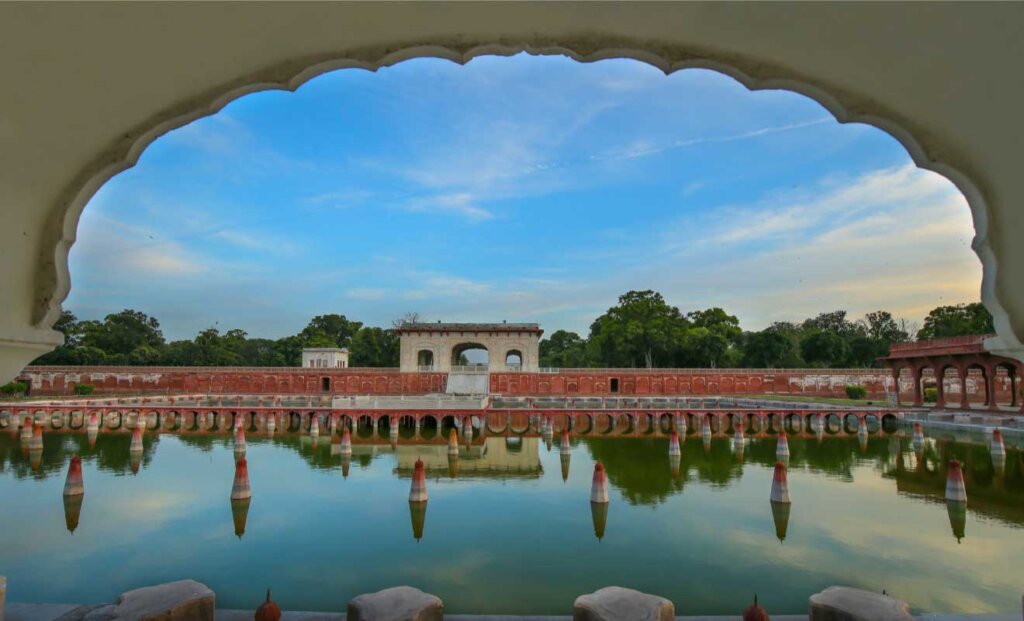
Lahore is a centuries-old Mughal city and home to multiple UNESCO World Heritage Sites, including Shalimar Gardens or Shalimar Bagh. It has been featured in many Lahore travel guides and visiting this Mughal garden complex is one of the best things to do in Lahore.
This historical landmark was constructed during the reign of Emperor Shah Jahan in the mid-16th century as a venue to entertain the guests of the Mughal royal family. Its design was influenced by Kashmir’s Shalimar Garden, which was built by Emperor Jahangir (Shah Jahan’s Father).
Kashmir’s Shalimar Gardens benefited from a naturally sloping landscape, while the waterworks in Lahore’s Shalimar’s Garden required extensive engineering to create artificial terraces and cascades. Its Persian quadrilateral garden is intended to create an earthly utopia in which people coexist peacefully with all elements of nature. This kind of traditional charbagh is also part of the famous Taj Mahal built by Shah Jahan.
It is one of the best outing places in Lahore. Located in Shalimar Town of Lahore, it is famous for its quadrilateral garden, perfectly arranged 410 fountains, and fretwork on the red masonry walls. This garden complex features more waterworks than any other Mughal Garden. Its architecture is inspired by Indian, Turkish, and Persian architecture, making it an excellent place for architecture and history lovers.
With hundreds of fountains, it also features numerous garden pavilions, a big pool with fountains, wide marble pools known as hauz, and a dozen tree varieties, making it one of the best family entertainment places in Lahore. This garden’s waterworks and dense foliage make it cooler than surrounding places.
The entry ticket to visit this garden complex is 20 rupees for locals and 500 rupees for foreigners. It can be accessed any day of the week between 8:00 AM and 6:00 PM. You can visit this tourist spot any time of the year.
 Location:
Location:
Shalamar Town, Lahore
 How to get there:
How to get there:
22-minute drive from Lahore Fort
 Highlights:
Highlights:
Terraces in the middle of the garden named Farah Baksh, Faiz Baksh, and Hayat Baksh, Baradaries, Naqar Khana, Diwan-e-Khas-o-Aam, 410 fountains and wide marble pools, five water cascades, seating pavilion, and souvenir shop.
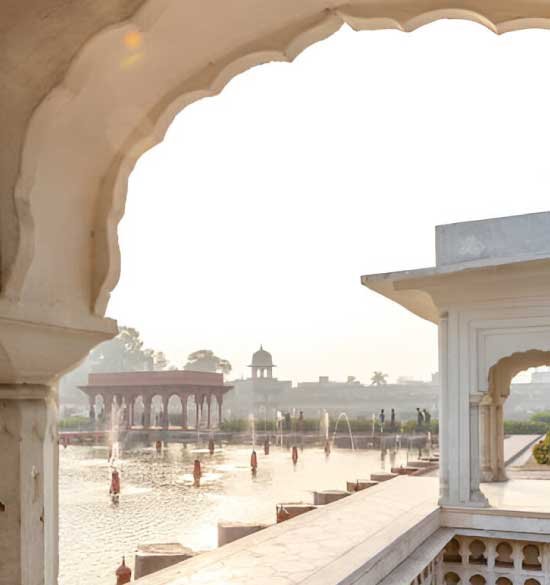
8-Jahnagir’s Tomb
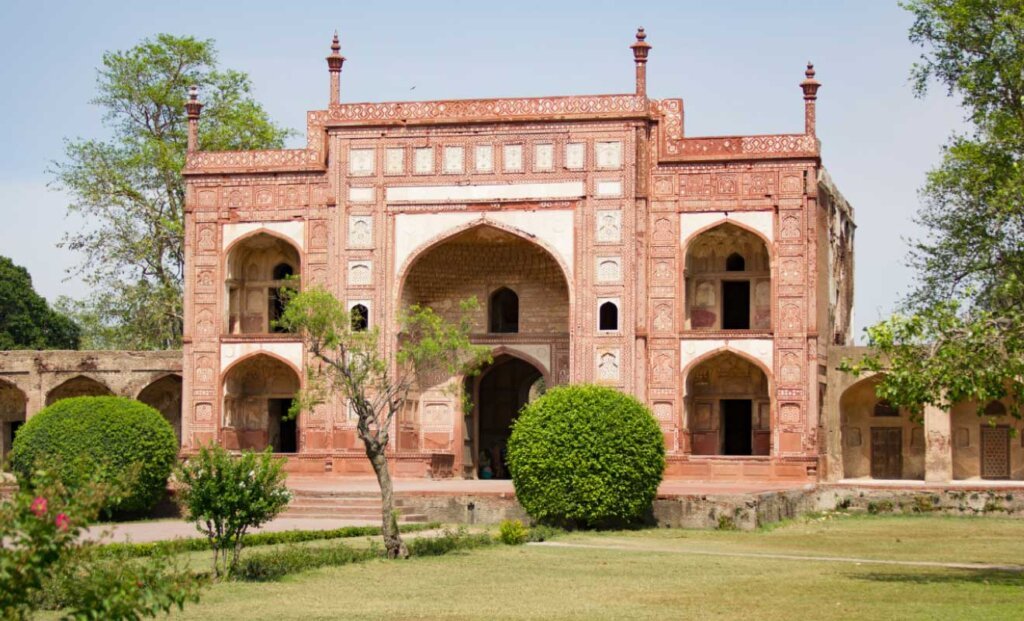
Another one of the best Lahore visiting places is the Tomb of Jahangir, which was built in the 17th century. It is believed that it was built under the direction of Jahangir’s wife, Empress Nur Jahan, after Jahangir’s death in 1627. This historical landmark of Lahore is located in Shahdara Bagh along the banks of River Ravi.
The mausoleum is at the center of the Dilkusha Garden, which had been Jahangir’s favorite spot during his lifetime. This square-shaped Tomb is surrounded by Persian-inspired charbhag that forms a quadrangle perfect for having picnics with family and unwinding after admiring the architectural beauty of the Tomb.
All four corners of the Jahangir’s Tomb are marked by four terraces and octagonal ornamental minarets topped by canopies that bear domes decorated with geometric inlaid white marble stone. This Mughal funerary architecture showcases beautifully decorated interiors and exteriors and features tile work, pichi kari, and intricate geometric and floral designs.
The exterior is richly decorated with intricate pietra dura in vegetal patterns, which are pictorial mosaics that take your breath away. In comparison, the interior is extensively embellished with frescoes and exquisite inlay marble. In addition, its interior features a portrait of Jahangir.
The walls are inlaid with carved white marble, and its façade is made with red sandstone. Entry to this one of the famous tourist attractions in Lahore is through the Akbari Sarai, which is located at its western edge and features a small mosque. The Tomb of Empress Nur Jahan and her brother Asif Khan are also located inside the Jahangir’s Tomb’s complex. Spend a few hours here, admire its architectural beauty, and relax in its garden.
 Location:
Location:
Jahangir Tomb Road, Lahore
 How to get there:
How to get there:
It takes around 23 minutes from Lahore Fort.
 Highlights:
Highlights:
A white-marble cenotaph inlaid with pietra dura, Persian-inspired gardens, intricate pichi kari work, fresco and title work, octagonal ornamental minarets, carved white marble work on walls, Akbari Sarai, the Tomb of Nur Jahan, and Asif Khan.

9-Minar-e-Pakistan

When it comes to the best Lahore places to visit, Minar-e-Pakistan is the first place that comes to everyone’s mind. This landmark is located inside the greater Iqbal Park, which symbolizes the movement of Pakistan as it is the vicinity where the Pakistan Resolution was passed in 1940, which led to the partition of the subcontinent later in 1947.
It stands 70m from the star-shaped base in the center of greater Iqbal Park. Known as a tower of Pakistan, this open landmark’s design is a mix of Mughal, modern and Islamic architecture.
There are 800-foot-long musical fountains, an artificial lake, and a vast park around this historic monument, making it more alluring. Visitors can take a golf cart tour to enjoy its lush surroundings. Taking an elevator ride to its top to get a panoramic view of the city was possible in the past, but it has been closed to the public for safety reasons.
This monument lies near the Badshahi Mosque, and visitors can get a fantastic view of it from the mosque’s aisle arch. There is no entrance ticket to Minar-e-Pakistan, and it is usually crowded on weekends, so visiting this landmark on weekdays is recommended.
 Location:
Location:
Inside Greater Iqbal Park
 How to get there:
How to get there:
Around 17-minute drive from Mall Road
 Highlights:
Highlights:
Well-kept gardens, artificial lake, plaques inscriptions include Quranic verses, national Anthem, Jinnah’s speeches, Allama-Iqbal’s poetry and text of the Lahore Resolution.

10- National History Museum
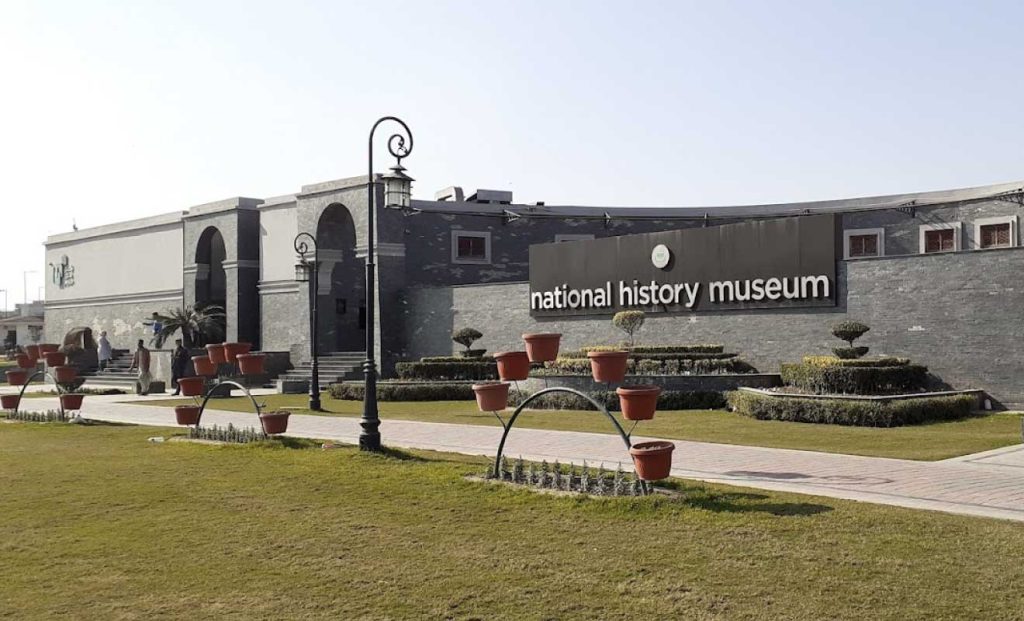
Lahore is home to many museums, including the Lahore Museum, Fakir Khana Museum, Shakir Ali Museum, Chughtai Museum, and National History Museum. If you want to learn the history of Pakistan through audio and visuals, you must visit the National History Museum located inside the greater Iqbal Park. This museum is a top-visiting place in Lahore.
It has five sections, each focusing on specific aspects of the country’s history and culture. It features 8700 digitized photos, holograms, interactive displays, cinema, and VR arrangements. The exhibits are interactive and well-displayed, which you will not see in other museums of Pakistan.
Visitors can see the struggle of refugees during the partition of Pakistan through a 3-D virtual reality show, listen to stories of women who played a crucial role in the Pakistan movement, and even take a picture with the father of the nation and other notable figures. It also features a large collection of national relics and antiquities, providing visitors insight into Pakistan’s history.
There are three categories of ticket fares to visit the National History Museum, ranging from 50 rupees to 250 rupees. Adding a few hundred rupees to the regular price allows the visitors to browse digital historical records using VR systems and explore the train bogie that showcases the partition events. Opening hours are between 10 AM and 6:00 PM from Tuesday to Sunday. However, the last entry time is 90 minutes before closing time.
 Location:
Location:
Inside Greater Iqbal Park
 How to get there:
How to get there:
A short walk from Minar-e-Pakistan
 Highlights:
Highlights:
Jinnah-Gandhi talks, Amphitheatres & cinemas, a timeline of Pakistani currency, audio-visual exhibits of the Lahore Resolution, a Heroes’ gallery, and a Train bogie showcasing events of partition.

11- Kamran’s Baradari
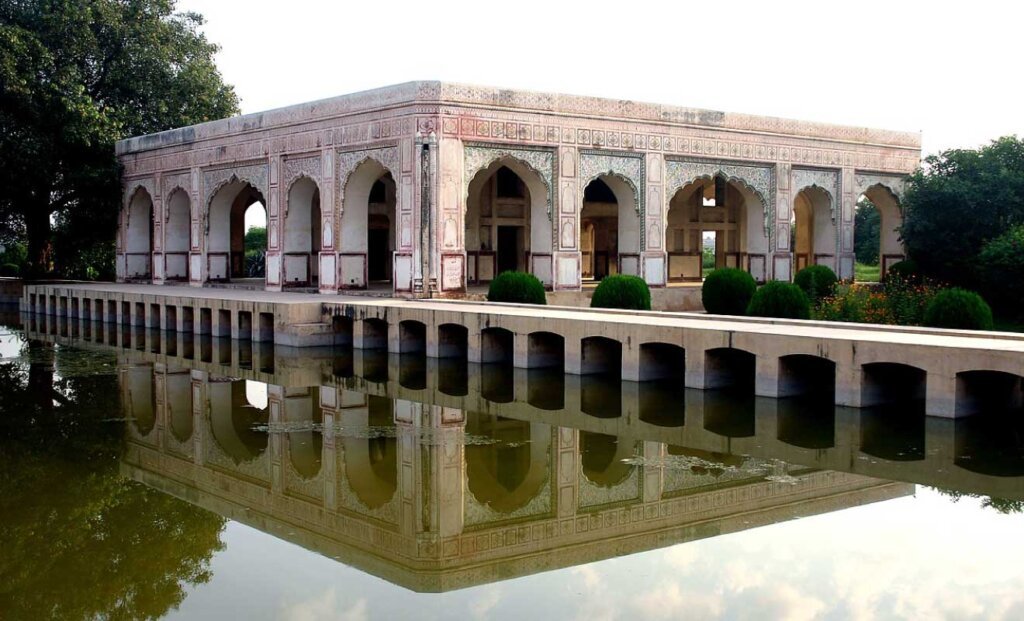
An offbeat addition to our list of best places to visit in Lahore is Kamran’s Baradari, which stands on a small island in River Ravi. It takes around one hour to get there from Lahore’s center. Baradari, or summer palace, is considered the oldest existing structure in Lahore, which was built during the Mughal period.
This summer palace was built by Prince Kamran Mirza, the son of the first Mughal emperor Babur, and remained in use by Mughal emperors until the 18th century. This two-storey pavilion has twelve doors surrounding the structure and twelve columns to hold its balconies. Its architecture reflects the finesses of craftsmanship during the Mughal era and is a treat to behold.
The pavilion is octagonal and decorated with floral motifs and intricate geometric patterns. It has cusped arches that create a sense of openness. The central hall features a high ceiling with several windows that filter the sunlight and illuminate the interior. Kamran’s Baradari is accessible via a short boat ride from Ravi Bridge to visit this one of the best offbeat places in Lahore.
A staircase leading to its roof is open for visitors, and the view from the upper storey is magnificent. From there, you can see this historical structure in the middle of the River Ravi from a bird’s-eye perspective. It is surrounded by a manicured garden, making it a perfect place for a picnic. It receives fewer tourists even on weekends than other tourist spots as it is located on the outskirts of Lahore. It is free to visit and can be accessed throughout daylight hours.
 Location:
Location:
In the middle of River Ravi
 How to get there:
How to get there:
Around 10 minute drive time from Minar-e-Pakistan
 Highlights:
Highlights:
Pavilion’s twelve doors, geometrically laid out gardens, intricate geometric patterns & floral motifs, beautiful views of the area from the upper storey, and the adjoining shrine of a Sufi saint.

12-Anarkali Bazar

Anarkali Bazaar is located in central Lahore, opposite the Lahore Museum. It is the oldest market in Asia, dating back to 200 years. This Bazaar is the best visiting place in Lahore, where you can shop, eat, or just observe the bustling activity of this centuries-old market. This bazaar is divided into the new Anarkali Bazaar and the old Anarkali Bazaar.
Old Anarkali bazaar hosts a variety of food stalls where visitors can try mouth-watering street food, including Dahi Bhalay, Chana Chaat, Choly Bhatury, and gol gappy. In the old section, you will also find traditional ethnic footwear. On the other hand, the new Anarkali Bazar is where you can shop for formal dresses, jewelry, wedding dresses, shoes, and a range of ready-to-wear dresses for all occasions.
Dhoni Ram Gali, Bano Bazaar, and Pan Gali are the famous markets within the Anarkali Bazaar. There are also many food points in New Anarkali Bazar, including the Zafar Halwa Puri shop that offers the best Halwa Puri in Lahore, made with wheat and desi ghee. If you want to avoid crowds and walk more peacefully, visit it during weekdays.
 Location:
Location:
In front of the Lahore Museum
 How to get there:
How to get there:
10 minute-drive from Mall Road.
 Highlights:
Highlights:
Traditional clothing, jewelry, food stalls, and local handicrafts.
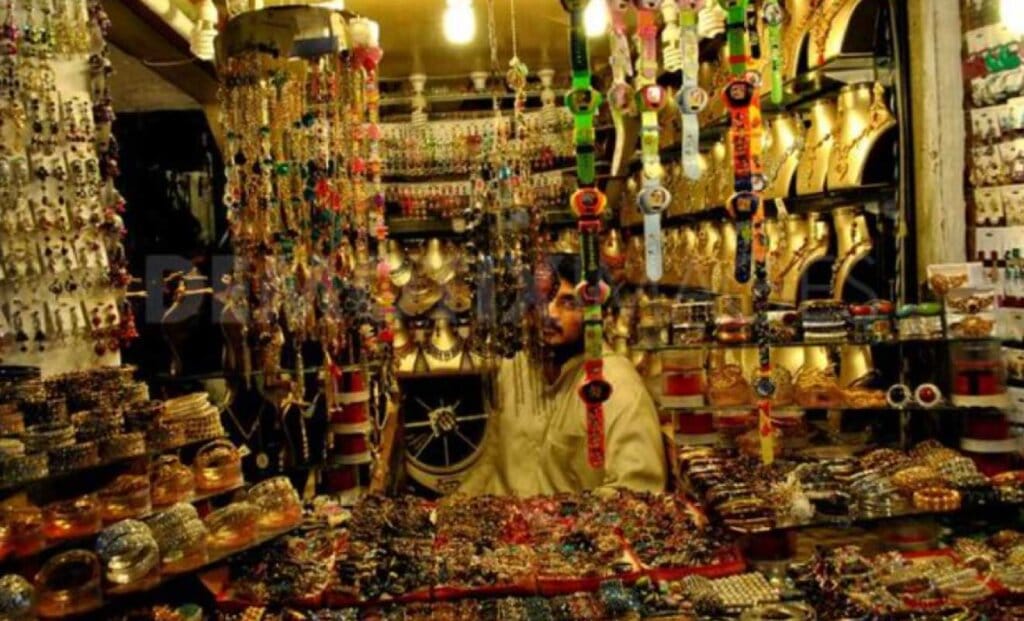
13-Wahga Border
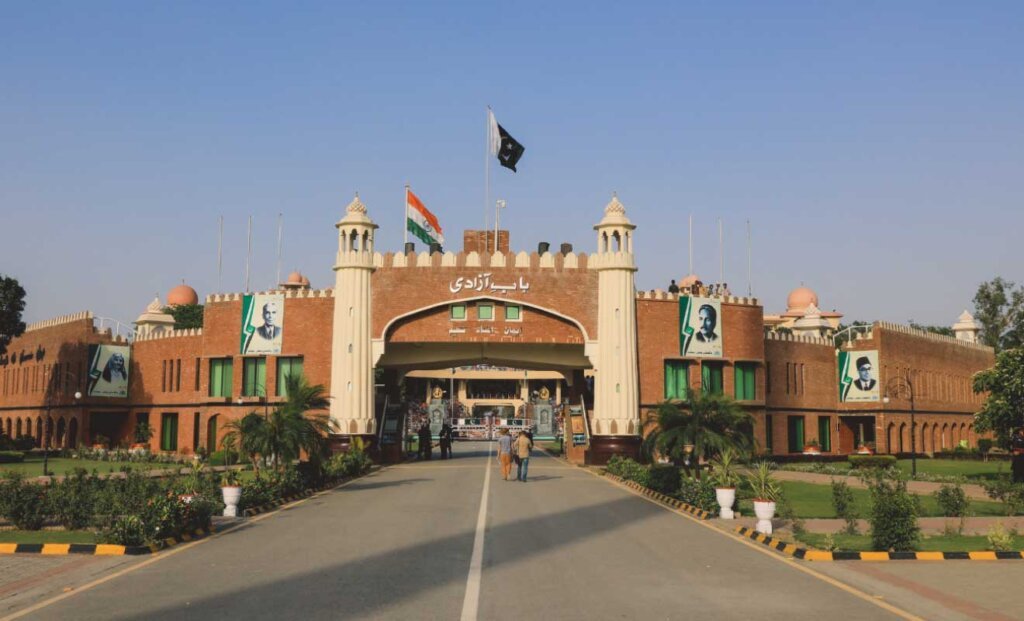
Wahga Border is located at a distance of 27 kilometers from Lahore City, which serves as the only land crossing point between Pakistan and India. Depending on your location, it takes around half an hour to fifty minutes to get there via GT Road. The traditional flag-lowering ceremony in the evening draws hundreds of people every day at the Wahga border. There is no fee for tourists to attend these daily ceremonies.
This Attari-Wagah border closing ceremony will entertain you in a different way. You might not see any military posturing example somewhere else that you will see at the Wahga Border. You will feel a sense of rivalry when you see soldiers from both sides outdo one another in marching, shout louder with ear-splitting commands, compete to show off who can kick higher, and twirl their fierce mustaches with menacing intent.
However, when tourists take a seat in the stands, they will witness synchronized marching displays, flag-waving, and crowds chanting ‘Pakistan Zindabad. This flag-lowering ceremony ends with the lowering and folding of the flags, followed by a brotherly handshake between Pakistani and Indian soldiers.
 Location:
Location:
27 km from Lahore
 How to get there:
How to get there:
It is easily accessible by road
 Highlights:
Highlights:
Watching the parade by the Pakistan Rangers, impressive high-kicks of border guards, Quaid-e-Azam Park, and Azadi Museum.
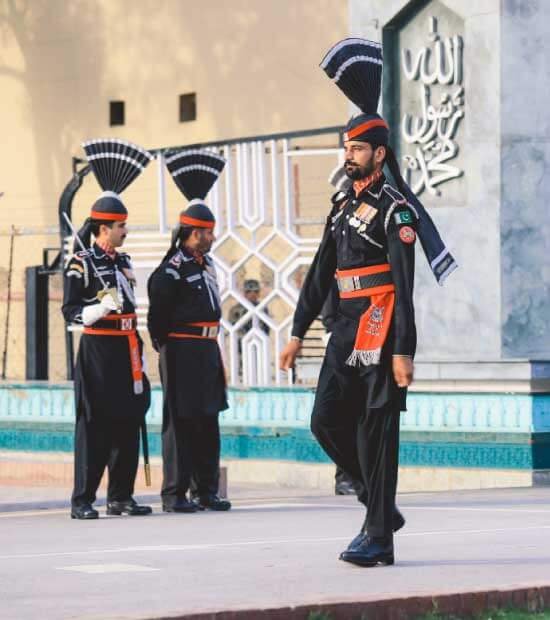
4-Fort Road Food Street
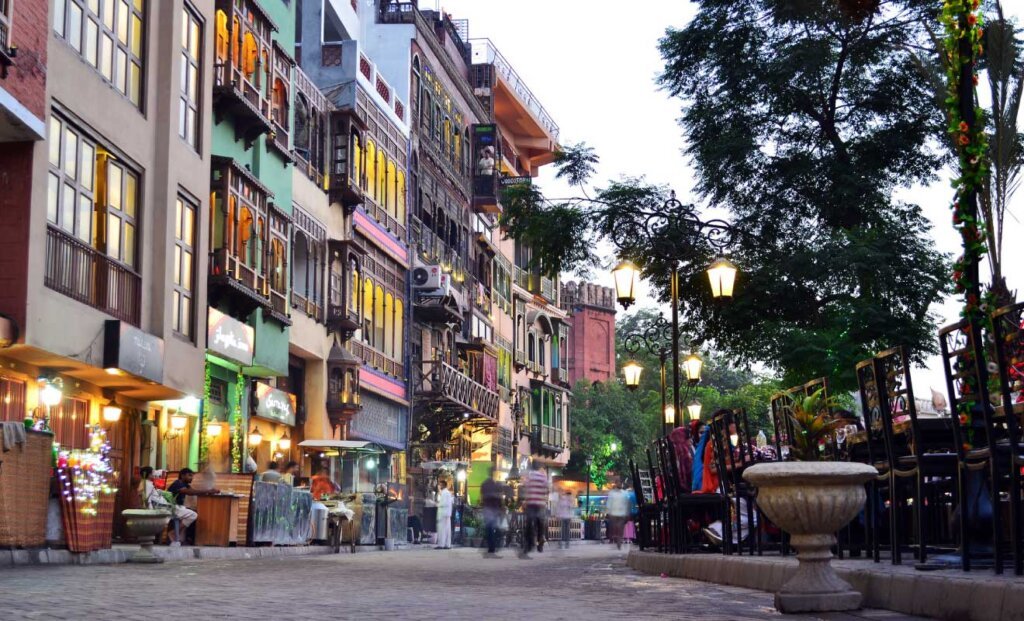
Lahore is not only the cultural capital of Pakistan but also a food capital where you can find a variety of drool-worthy dishes waiting for you to eat. Lahore has many food streets like Old Anarkali Food Street, Gawalmandi Food Street, Lakshmi Chowk Food Street, and Fort Road Food Street. Fort Road Food Street is the most famous food street in Lahore, which is considered one of the best Lahore visiting places.
Food Street is considered one of the best places to eat in Lahore, thanks to its proximity to Badshahi Mosque and decade-old restaurants that serve delicious food. This food street is lined up with colorful tall buildings built during the Mughal Empire and British rule. Each building is painted in different colors from the ones next to it and features carved wooden doors and jharokas (Wooden balconies), which reflect the persona of the old city of Lahore.
Some restaurants like Andaaz Restaurant, Haveli Restaurant, and Cooco’s Den offer a majestic view of Badshahi Mosque. The top rooftop of Haveli Restaurant also provides a view of Lahore Fort. With exquisite views, these restaurants are famous for their mouth-watering menu, including chicken handi, karahi, BBQ, Siri Paye nihari, and biryani.
Visitors can feast on delicious food while enjoying the notes of live music played by local musicians. With traditional Pakistani cuisine, don’t forget to try Pakistani street food like chana chat, gol gappay, dahi bhalay, and more. It is recommended to visit this place before sunset, and enjoy stunning sunset views over Badshahi Mosque, and feast on scrumptious desi food.
 Location:
Location:
Fort Road, Shahi Mohallah, Walled City, Lahore,
 How to get there:
How to get there:
A Short walk from Badshahi Mosque
 Highlights:
Highlights:
Spectacular views of Badshahi Mosque from Haveli Restaurant, delicious desi food, museum-like-restaurant of Cooco’s Den, sunset views over Badshahi Mosque, and handicraft shops.
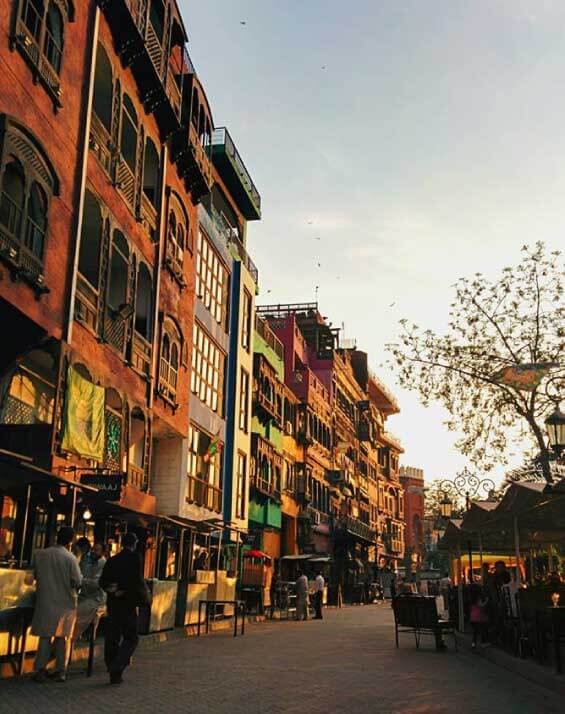
15- Lahore museum
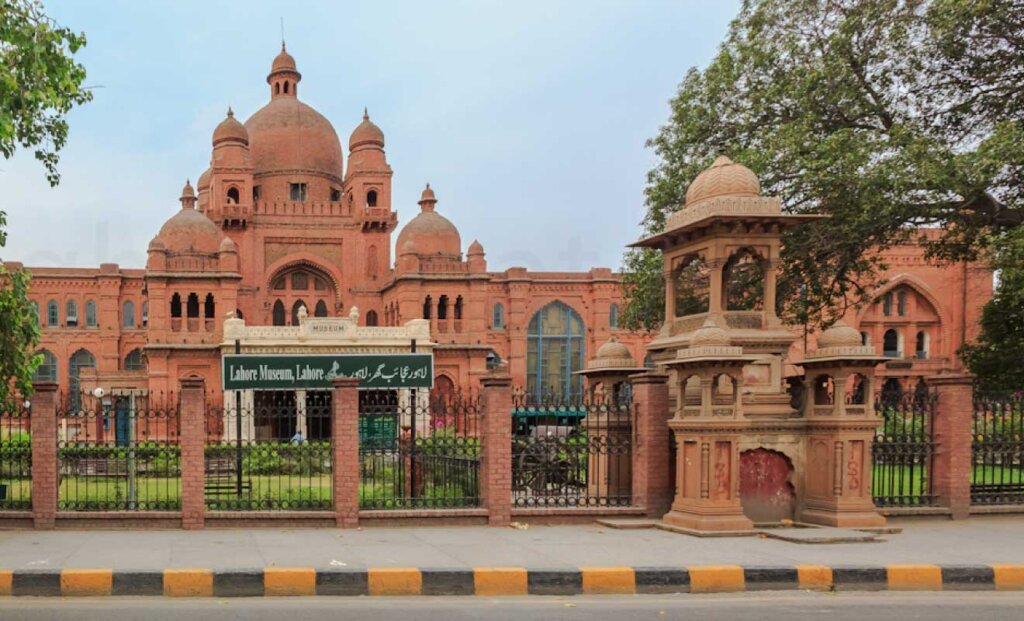
Lahore Museum is the most visited museum in Lahore, which is located near Anarkali Bazaar on Mall Road. It is also Pakistan’s largest museum, with a collection of over 58,000 artifacts. This museum is one of the best places to visit in Lahore, which offers an in-depth insight into Pakistan’s history and culture from the Mughal era to the freedom movement of Pakistan.
Founded in 1865 during British rule, the Lahore Museum houses the oldest and largest collection of cultural and historical artifacts of Pakistan, such as ancient jewelry, Buddist art, old coins and stamps, musical instruments, and rare manuscripts. You will also find a collection of Buddhist art from Gandhara and relics from the Indo-Greek Kingdom. It also features the famous statue of Fasting Buddha from Gandhara, which is the finest specimen of Gandhara Art. In addition, the museum has several collections from the Mughal period, the Sikh Empire, and the British Empire.
Opening hours are between 9 am and 5 pm from Saturdays to Thursdays. The entry ticket fee is 50 rupees for locals and 1000 rupees for foreigners. Mobile phones are allowed inside the museum. If you want to take some good shots with a professional camera, you need to pay some amount to bring your camera inside the museum.
 Location:
Location:
Mall Road Lahore
 How to get there:
How to get there:
2-minute walk from Anarkali Bazaar
 Highlights:
Highlights:
The Gandhara Gallery, statue of Fasting Buddha, miniature paintings, Coins Gallery, collections from Mughal, Sikh, and British Empire.
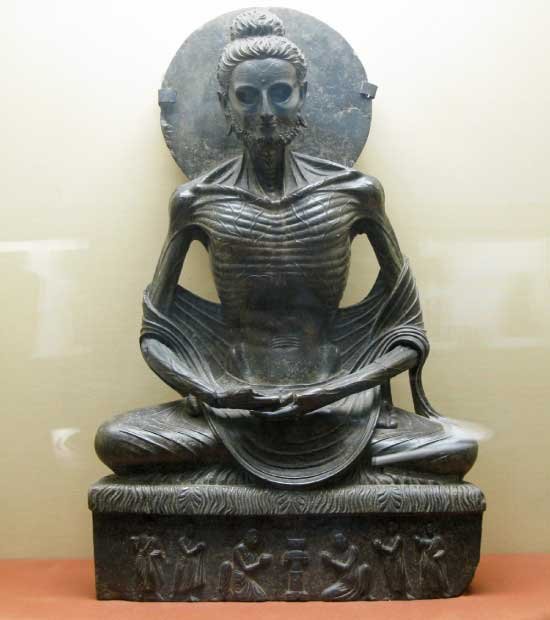
The Bottom Line
A common saying is, “If you haven’t seen Lahore, you haven’t even lived.” This saying is true in so many ways. Lahore is an ancient Mughal city, which is not only a UNESCO City of Literature but also features heritage sites, iconic landmarks, and historic structures that form its identity and culture.
It is a treasure trove for culture seekers and history buffs, from Persian-style Shalimar Gardens to the planet’s most striking religious buildings like Badshahi Mosque and Wazir Khan Masjid, and 11th century-old Lahore Fort to narrow lanes of the Walled City of Lahore that echoing tales of the Mughal grandeur.
Above all, the people of this marvelous city are so hospitable and generous. That’s why they earn the title Zinda Dilan-e-Lahore or lively people of Lahore, making it Lahore Lahore aey (a famous phrase that means Lahore is Lahore) in true meaning.
We hope our guide on the best places to visit in Lahore gives you a better idea of what to explore in this world’s most eccentric city and what to expect when you are there. Have you ever visited Lahore? Which place did you like the most? Let us know in the comment below!
After discovering the best places in Lahore, consider reading our guide about the best places to visit in Islamabad to learn about the places you must visit on your trip to Islamabad.
You might also like:
Most beautiful places in Pakistan
Top 10 Best Places You Must Visit on Your Trip to Naran Valley
Top 10 Best Azad Kashmir Beautiful Places in Pakistan
Disclaimer:
Vacay Adviser claims no credit for images featured on our blog site unless otherwise noted. All visual content is copyrighted to its respectful owners. We try to link back to original sources whenever possible. If you own the rights to any of the images and do not wish them to appear on Vacay Adviser, please contact us and they will be promptly removed. We believe in providing proper attribution to the original author, artist, or photographer.


